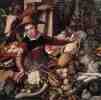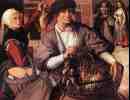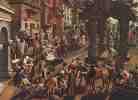![]()
Aertsen, Pieter (b. 1508-09, Amsterdam, d. 1575, Amsterdam). Netherlandish painter, active in his native Amsterdam and in Antwerp. A pioneer of still life and genre painting, he is best known for scenes that at first glance look like pure examples of these types, but which in fact have a religious scene incorporated in them (Butcher's Stall with the Flight into Egypt, University of Uppsala, 1551). His depictions of food, flowers, and everyday objects make him important in the development of still-life painting. Aertsen was the head of a long dynasty of painters, of whom the most talented was his nephew and pupil Joachim Bueckelaer.
Nicknamed Lange Pier (Peter the Long), born in Amsterdam, he became a citizen of Antwerp in 1542 where he resided until around 1556. Hosted initially by Jan Mandyn, a gifted follower of Hieronymus Bosch, Pieter Aertsen links the Dutch and the Flemish schools. His sons, Pieter Pietersz and Aert Pieterz, also became painters. Aertsen also trained his nephew Joachim Beuckelaer.
During his first years in Antwerp he was mainly commissioned to make altarpieces for Dutch churches. Before long he also started to paint scenes from peasant life and he gained a reputation for his paintings of market scenes and "kitchen" tableaux, which contained an abundance of fruit, fish, poultry, cheese, bread and much more.
Renowned today as the painter of "kitchens" (Christ with Maria and Martha), featuring an opulent and familiar realism, he is in fact a varied and ambitious painter, tackling both religious compositions, genre scenes and portrait: his career can be traced between 1543 and 1571 with a series of signed and dated artworks. Today he is considered as important as Bruegel among 16th century painting: a powerful and monumental artist, using splendid and frank tones, announcing the Flemish still-life developments with such realism and surcharge of details.
His compositions packed at the front with vegetables reflect a mannerist pathos specific to the 16th century; however if religious figuration is often relegated in the background in a subordinated position (a scheme that will later have much success, among his younger cousin and pupil Beuckelaer for instance, who took over this style of painting and developed it further), the religious painter should not be ignored, with such massive formats and powerful ambitions. He was tormented by iconoclasts and practiced a heroic and dignified style, close to and competing with Floris.
![]() Market Scene, c. 1550, Ecce Homo fragment
Market Scene, c. 1550, Ecce Homo fragment
 Vendor of Fowl
Vendor of Fowl
Oil on panel, 137 x 95 cm;
The Hermitage, St. Petersburg
 Vendor of Vegetable
Vendor of Vegetable
Oil on wood;
Staatliche Museen, Berlin
 The Adoration of the Shepherds
The Adoration of the Shepherds
Oil on wood;
Musée des Beaux-Arts, Rouen
![]() Butcher's Stall with the Flight into Egypt
Butcher's Stall with the Flight into Egypt
![]() Scenes from the Life of an Unidentified Bishop Saint
Scenes from the Life of an Unidentified Bishop Saint
 Market Scene
Market Scene
Oil on oak wood, 91 x 112 cm
Kunsthistorisches Museum, Vienna
![]() Market Woman with Vegetable Stall
Market Woman with Vegetable Stall
 Apostles Peter and John
Apostles Peter and John
1575; Oil on wood, 55.5 x 76 cm;
The Hermitage, St. Petersburg;
Earlier the painting was attributed to Joachim Beuckelaer, Aertsen's pupil.
During the religious riots of 1566, radical Protestants destroyed statues in Catholic churches and monasteries. It began on 10 August in Steenvoorde in West Flanders. Following a sermon by a Calvinist minister, part of the congregation forced its way into the nearby St Lawrence monastery and smashed all the statues. It was the beginning of a wave of destruction which quickly spread across the rest of the country. This was the culmination of a series of events. The repression of church reform had raised tensions to breaking point. Moreover, unemployment and poverty were rife in this period of economic crisis: the seedbed of social unrest. Defacing the churches was justified by the Calvinist belief that statues in a house of God were idolatrous images which must be destroyed.